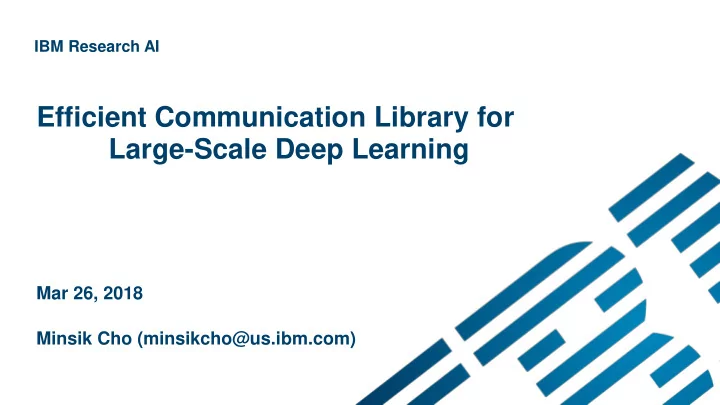

IBM Research AI Efficient Communication Library for Large-Scale Deep Learning Mar 26, 2018 Minsik Cho (minsikcho@us.ibm.com)
Deep Learning changing Our Life Automotive/transportation Medicine and Biology Security/public safety Consumer Web, Mobile, Retail Media and Entertainment 2
IBM Deep Learning Workflow Latency to model: Typically days to train complex models This is my focus Limited by training compute throughput Training Forward Conversion/Retraining Trained Needed if training/inference precisions differ Error Model Training Data Backward (grouped in large minibatches) Next Minibatch Inference Next Epoch Model Inference Batching Forward Action Smaller, varied batch size: Application-dependent Application- Input Data dependent Individual E.g., from microservices Latency to action: Typically ms to complete full inference workflow Limited by latency of batching (to enable efficient inference) + inference compute+ resultant action 3 3
Advance in Computation for Deep Learning [P. Goldsborough] [MichaelGalloy.com] /FPGA • 10-100 TFLOPS • Very good scaling for last 15 years 4
Motivation: Ok, ever-fast computation. Is this enough? • ImageNet1K : 1.2M images, 1K classes, Resnet101 – Batch-size = 32 (limited by GPU memory) – Iteration time = 300ms – #iterations per epoch = 38000 – Total training time for 100 epoch = 13.2 days • ImageNet22K : 7.5M images, 22K classes , Resnet101 – Total training time for 100 epoch = 35.2 days • No, it is NOT – 1.2M samples are still at toy scale – Computation scaling is not fast enough • the data explosion/model complexity • Innovation will take too long, or even stop at some point – I cannot wait for days to get my model trained! 5
Faster Training Time with Distributed Deep Learning 9 Days Recognition What will you do? 4 Hours 4 Hours 4 Hours 4 Hours 4 Hours 4 Hours 4 Hours 4 Hours 4 Hours 4 Hours 4 Hours 4 Hours Iterate more and create more accurate models? Create more models? Both? Recognition 54x Learning runs with Power 8 6
Distributed Deep Learning Gradient/weight (10MB-1GB) [P. Goldsborough] Anything Data parallelism : Parm-Server Model parallelism (complex partitioning) Data parallelism : Allreduce 7
Communication : Overhead sync sync 32 images 32 images 32 images 32 images 32 images 32 images 32 images 32 images 32 images 32 images • In weak-scaling – Computation cost remains constant – Communication cost increases with more learners/GPUs • Computation /Communication is the key for large-scale deep learning – Increase Computation – Faster Communication 8
Advance in Communication for Deep Learning • Still scaling, but not fast enough – Computation is still ahead – Data perhaps grows much faster 9
Designing Large-scale Deep Learning Computation Communication Model depth Gradient count GPU throughput Network BW Good balance Faster algorithm Faster algorithm Mini-batch size • Model/Application • Deeper/wider model to increase compute time • Smaller gradient count to reduce communication time • System • Balance network and computing resources • Select mini-batch size to adjust the ratio • Larger mini-batch size to lower the ratio • Too big mini-batch size can hurt convergence and accuracy • Network-topology aware communication 10
IBM PowerAI DDL (Distributed Deep Learning Library) • Collaborative communication library for Distributed Deep Learning – MPI-like interface for easy-integration – Enables deep learning software to scale to 100s severs with CPU/GPUs – Works across variety of system sizes – Works with variety of network types, switch topologies • DDL orchestrates the data communication – Plan efficient communication pattern on a hierarchal network environment – Actual point-point data transfer via NCCL or MPI • Currently integrated into – Supported: Caffe, Tensorflow, Chainer, Torch – Ongoing : Caffe2, PyTorch, Keras (TF-backend) • Currently US patent-pending 11
DDL : Topology-aware communication Max bandwidth: 10 Gbytes/sec switch0 switch1 Max sustained bandwidth: 100 Gbytes/sec A B D C • Example A->B B->C C->D – A, B, C, D broadcast to all others B->C C->D D->A – Suffers from congestion – Suffers from lower BW C->D D->A A->B D->A A->B B->C 12
DDL : Topology-aware communication A->B B->C C->D switch0 switch1 B->C C->D D->A suboptimal C->D D->A A->B box0 box1 box2 box3 D->A A->B B->C A B D C • It’s a mapping problem A->B B->C C->D – System-specific network B->A A->D – Application-specific traffic D->C Optimal • DDL does differently C->D D->A A->B – To minimize bus contention D->C C->B B->A – To minimize crossing lower BW 13
DDL : Problem Definition and Solution • Assumption – network topology with various bandwidths • Problem Definition – min-cost multi-commodity flow problem – NP-hard problem but can be solved easily if graph size is small (ie 4 vertices) • DDL solves a typical case/topology offline – if the cluster/cloud has provide such topology, it performs very well 14
DDL : How well it performs on Caffe2 DDL DDL • 48 IBM S822LC with PPC64LE RHEL – 3 racks and 16 hosts on each, connected though 10GB/s IB – Each host has 4 P100-SXM2 with CUDA8, CUDNN5 • Comparing algorithms on Resnet50 + Imagenet1K (preloaded to RAMDisk) mbs=32 – MPI_Allreduce – Ring (all-reduce from Baidu in Feb 2017) – GLOO (from Facebook) : NCCL+ib_verb 15
Comparison with NCCL 2.1.x Allreduce (POWER) Exploiting in-system topology Exploiting in/cross-system topology • IBM P9 Newell Systems (NVLink) with V100s • 100Gbps InfiniBand 16
Comparison with NCCL 2.1.x Allreduce (X86) NO in-system topology Exploiting cross-system topology • X86 Systems (PCIe) with P100s • 10Gbps Ethernet 17
Conclusion • DDL is a topology-aware communication library in PowerAI • DDL delivers the industry-best performance with – Network hierarchy – Multi-tier bandwidth • DDL is suitable for common distributed training on cloud environment 18
BACKUP 19
Recommend
More recommend